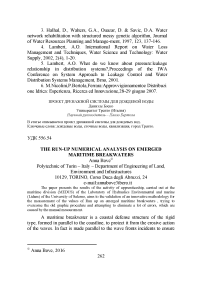The run-up numerical analysis on emerged maritime breakwaters
Автор: Bove Anna
Журнал: Антропогенная трансформация природной среды @atps-psu
Рубрика: Проблемы городской среды
Статья в выпуске: 2, 2016 года.
Бесплатный доступ
The paper presents the results of the activity of apprenticeship, carried out at the maritime division (MEDUS) of the Laboratory of Hydraulics Environmental and marine (Lidam) of the University of Salerno, aims to the validation of an innovative methodology for the measurement of the values of Run up on emerged maritime breakwaters, trying to overcome the old graphic procedure and attempting to eliminate a lot of errors, which are caused by the manual measurement.
Короткий адрес: https://sciup.org/147226763
IDR: 147226763 | УДК: 556.54
Текст научной статьи The run-up numerical analysis on emerged maritime breakwaters
THE RUN-UP NUMERICAL ANALYSIS ON EMERGED MARITIME BREAKWATERS
Anna Bove®
Polytechnic of Turin - Italy - Department of Engineering of Land, Environment and Infrastuctures
10129, TORINO, Corso Duca degli Abruzzi, 24
The paper presents the results of the activity of apprenticeship, carried out at the maritime division (MEDUS) of the Laboratory of Hydraulics Environmental and marine (Lidam) of the University of Salerno, aims to the validation of an innovative methodology for the measurement of the values of Run up on emerged maritime breakwaters , trying to overcome the old graphic procedure and attempting to eliminate a lot of errors, which are caused by the manual measurement.
A maritime breakwater is a coastal defense structure of the rigid type, formed in parallel to the coastline, to protect it from the erosive action of the waves. In fact is made parallel to the wave fronts incidents to ensure
® Anna Bove, 2016
that the wave arriving on the coast, is not going to break on it but on specially designed structure, dissipating, in whole or in part, its energy.
Depending on the height of the crest of the structure with respect to the average sea level, the breakwater barriers could be called emerging, low crest or submerged. Especially for rubble mounds, the structural element which ensures the dissipation of energy possessed by the incident wave is the outer armour layer, composed by blocks of concrete or rocks in which water flows through complex paths with unsteady motion.
The armour of stone and concrete armored unit in this outer layer are usually arranged with care to obtain effective systems of interlocking and consequently a better stability, allowing the overall protection of the structure against the attacks of a wave. The effective in dissipating a breakwater structure is ensured by the slope of the profile and the shape of the block. The structures analyzed are realized in Accropodo™, artificial units in concrete, which are distinguished by the high structural and hydraulic strength and by the high degree of interlocking.
The verification of the hydraulic efficiency and stability of an emerged maritime breakwater is currently carried out through a numerical modeling that, by means of the integrated use of CAD software and numeric, permits to study, with an approach more detailed, the hydrodynamics of the wave motion on a maritime work in the casting and the hydraulic stability of the boulders which constitute the armour.

CubeAntifer Tetrapod

Xbfoc* Accropode™ Core-loc™
Picture 1: Modeling of a rubble mound breakwater by means of the superposition of the individual structural elements
The geometrical model of the opera, built in the CAD environment, is imported in a CFD software that by integrating the equations of Navier Stokes mediated to Reynolds (RANS) and by coupling a model of turbulence, allows to evaluate the hydrodynamic interactions.
For tliis purpose, the wave motion is simulated through random waves imposing certain values of fetch and wind speed. For each simulation the Flow3Ds modeling software numerical hydrodynamic, provides a graphical representation of the evolution of the free surface of the sea in the vicinity of the structure, returning frames at regular time intervals of 0.5 seconds, tliat are imported into CAD environment for the manual detection of Run-up measures, the value of maximum ascent of the water along the structure with respect to the average sea level.
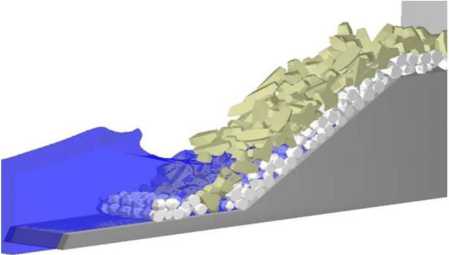
Picture 2: Numerical modeling of a barrier of Accropodi™ using Flow3D
The graphic procedure, consisting of a manual measurement of the values of the ascent of the wave to be carried out for each single frame provided by software, in addition to requiring a considerable amount of work provides values inevitably affected by an error bound on the accuracy of the operator and the resolution of the frame itself. In tliis sense the possibility of automating the measurement values mn up. entnisting it to a dedicated software, assumes a considerable interest.
So the apprenticeship activities meant to support the implementation of a software for the measurement of the mn-up. developed by Prof. Ing. Dentale Fabio, through its validation, in order to guarantee the accuracy, reliability and efficiency, achieving the possibility of overcoming the graphic procedure "traditional.
Therefore the phenomenon of Run up was analysed by an innovative numerical procedure, namely by means of an algorithm tliat detects the maximum ascent of the incident wave on the face of the breakwater barrier emerged as share, on the middle sea. of the point of intersection between the mass of water and the profile of the structure, exploiting a vectorial representation of the water mass in motion, obtained as the script of the text file "Free Surface Elevation", returned by the software Folw3D for each simulation, and profile of the armour of the breakwater barrier, reproduced as script in the file text "Stmcture.txt".
The methodology of analysis of the phenomenon of Run up remains unchanged, except for the measurement, entrusted exclusively to the program, which replaces the graphic method, allowing a considerable simplification of the procedure for detecting the values of Run up. From an operational point of view is made necessary a preliminary recalibration of the algorithm carried out on the basis of the results from the comparison between the values of Run up provided by two different procedures, graphical and numerical. This phase has constituted a fundamental moment in the tuning software since the direct comparison lias allowed the reconnaissance of criticality: identified imperfections, it was possible to recalibrate correctly the algorithm, optimising its use.
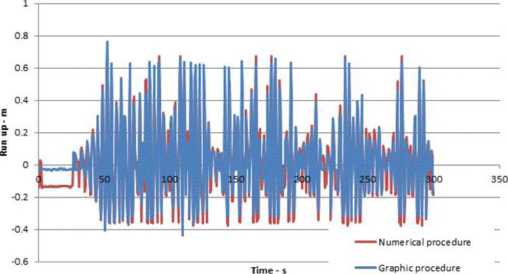
Picture 3: The comparison of the values of Run up obtained through the numerical procedure, in blue, and the graphic procedure, in red, applied to the breakwater banter slope of 2:3.
The comparison revealed that although reduced, there remains a certain offset between the values obtained through the two different approaches. The residual error - locally may assume values even of 10% - is due to the mode of frame representation, which is used by the software Flow3D. In fact by superimposing on a generic frame the polygonal reproducing the breakwater’s annour and the profile of the water mass, it can detect a gap between the two representations of the profile of the incident wave. The Flow3D in the frame processing, provides a raster representation of the wave rising, as well as of the structure, whereas only the cells of the grid with a high density, disregarding those partially filled, that in the image should be to bridge the gap between the polygon reproducing the ESF and the mass of water represented in the frame.
i-ve«K«y contours
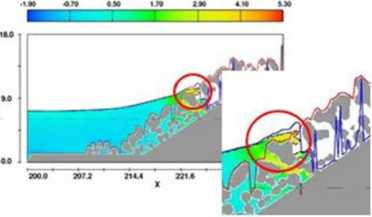
Picture 4: Gap of representation of the frame.
The error comes from non-representation of a part of the wave lifts in which obviously will affect the graphic procedure and not the numeric.
Suitably calibrated and modified the software in order to be able to evaluate the reliability, the procedure of numerical analysis of Run up was performed for each simulation of the interaction of the wave motion with the emerged maritime breakwaters, slope 2:3 and 1:2. supplied by the software Flow3D. For each simulation were products representative graphs of the variation in time of the run up and subsequently have been extrapolated values synthetic, having statistical value, i.e. those values of upwelling exceeded with a given frequency.
The values of Run up returned by the numerical procedure and by the graphic procedure, performed for each simulation, were validated through empirical formulas available in literature, in order to be able to evaluate the ability of the numerical model to interpret the upwelling phenomenon of the wave on a breakwater barrier emerged.
In conclusion, on the basis of the above findings, the comparative analysis between the values of Run up. obtained by applying the two different methodologies, lias proven reliability of numerical procedure on the ground tliat this function returns values tliat slightly deviate from the similar ones obtained by manual measurement. Furthermore, through comparative analysis between these and the values obtained through the formulas of literature, it lias been demonstrated tliat the numerical modeling effectively interprets the upwelling phenomenon of the wave on an emerged maritime breakwater despite the results to have distortion of base which can however be corrected with a suitable calibration of the model. In fact, in addition to return more accurate values since it eliminates errors committed by the operator in the seat of manual measurement, the numerical procedure allows to perform measurements of Run up with a temporal increasing frequency, reducing the burden of work, since the operator intervenes by directing the software to text fde of reproduction of the stmcture and of the free surface elevation, to process and proceed to the analysis of the values that this will return.
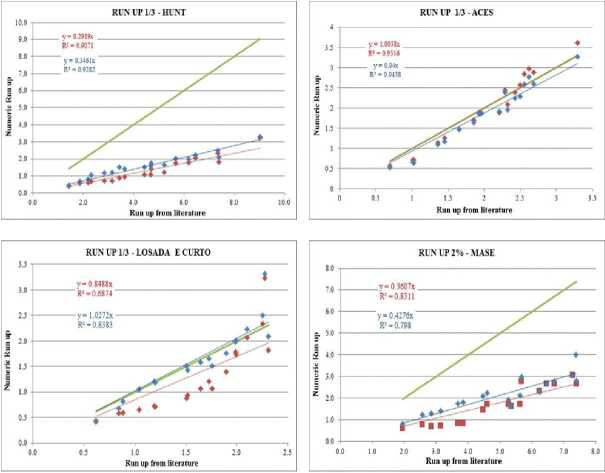
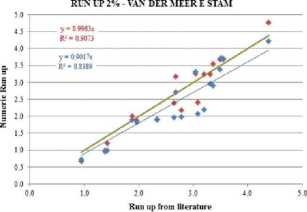
Picture 5: Validation of the numerical and graphic procedure through empirical formulas available in literature.
। From literature
--Numerical procedure
-------- Graphic procedure
Список литературы The run-up numerical analysis on emerged maritime breakwaters
- BARBA SALVATORE, DENTALE FABIO, MESSINA BARBARA - Barriere frangiflutti virtuali: dal modello reale al. modello numerico - IX International Forum Le Vie dei Mercanti, Aversa, Capri 910-11 June 2011.
- DENTALE FABIO(MEDUS), DONNARUMMA GIOVANNA(MEDUS), PUGLIESE CARRATELLI EUGENIO(CUGRI) - An innovative numerical procedure to study the maritime structures -International workshop on Flash flood and Debris flow Risk Management in Mediterranean areas - Salerno, 26th Jenuary 2012.
- DONNARUMMA GIOVANNA - Analisi numerica del moto ondoso su frangiflutti emerso - Tesi di laurea specialistica in Idrauluca Marittima (a.a.2009/2010), Facolta di Ingegneria per l'Ambiente e il Territorio, Universita degli Studi di Salerno.
- JULIEN DE ROUCK, RAF VERDONCK, PETER TROUCH, LUC VAN DAMME, FLEMMING SCHLUTTER, JOHN DE RONDE - Wave Run up and Overtopping prototype versus scale models - 3.1 Wave Run up, Costal Engineering 1998.
- GUGLIELMETTI PIETRO- Analisi numerica del run up e della riflessione di un 'opera marittima emersa- Tesi di Laurea in Ingegneria per l'Ambiente e il Territorio (a.a.2011/2012), Universita degli Studi di Salerno.
- GODA Y., SUZUKI Y. - Estimation of incident and reflected waves in random wave experiments- ASCE, Proc. Of 15th International conference on coastal engineeering- Honolulu, Hawaii, 1976
- STOPPIELLO MARIA GRAZIA-Analisi numerica della risalita del moto ondoso su strutture portuali con diverse pendenze della mantellata - Tesi di Laurea in Ingegneria Civile per l'Ambiente e il Territorio (a.a.2012/2013), Universita degli Studi di Salerno.
- DIPACE PASQUALE - Riflessione di onde regolari in presenza di opere a gettata - Tesi di Dottorato di ricerca in ingegneria idraulica, Universita degli studi di Napoli "Federico II".
- DENTALE F., PUGLIESE CARRATELLI E., RUSSO S.D., MASCETTI S. - Advanced numerical simulations on the interaction between waves and rubble mound breakwaters

